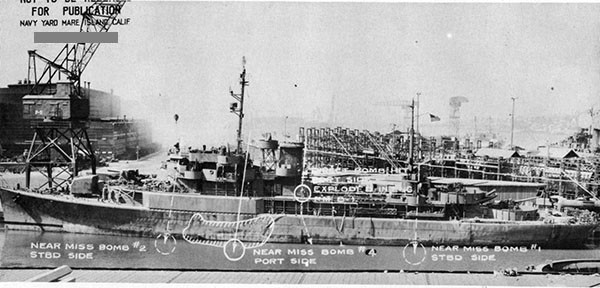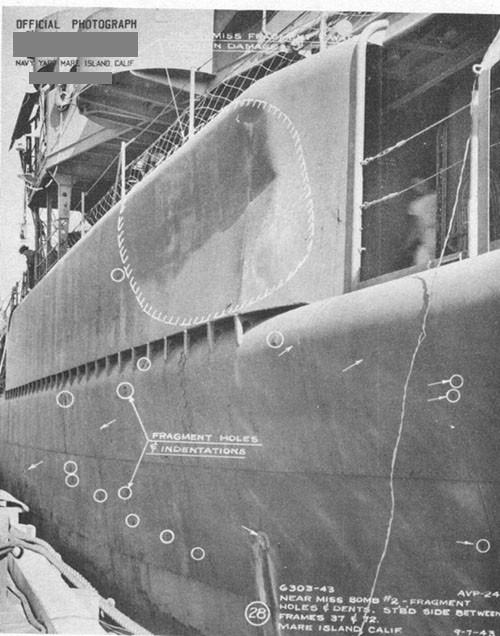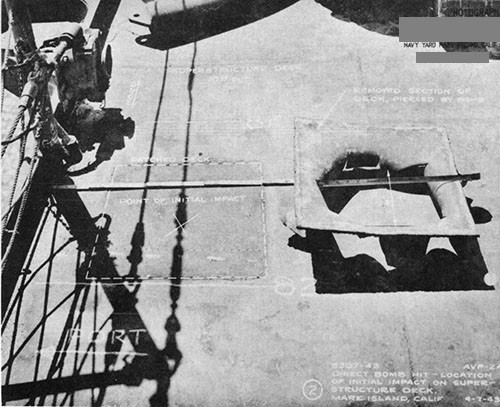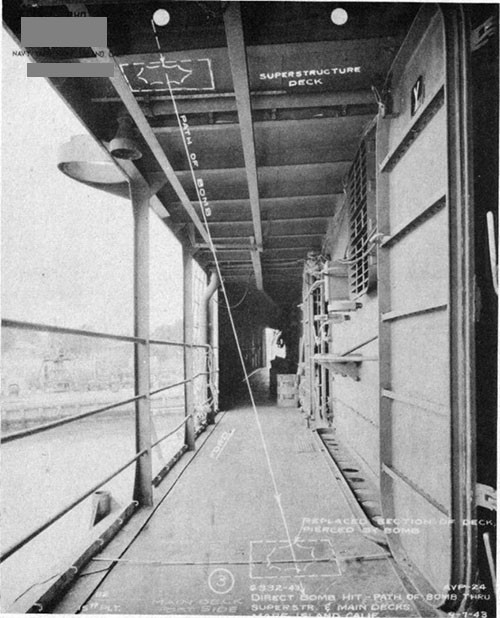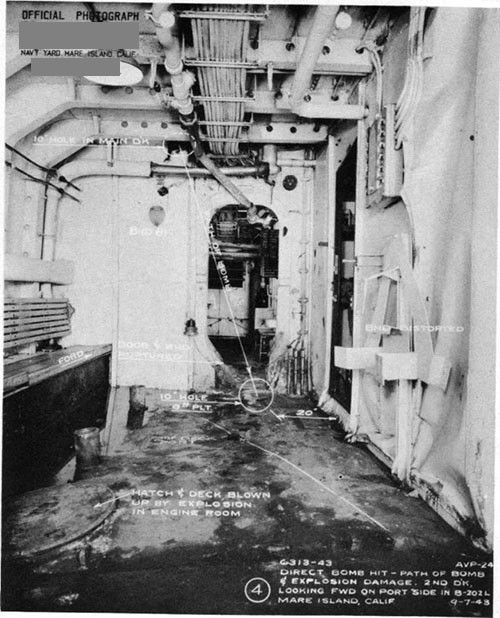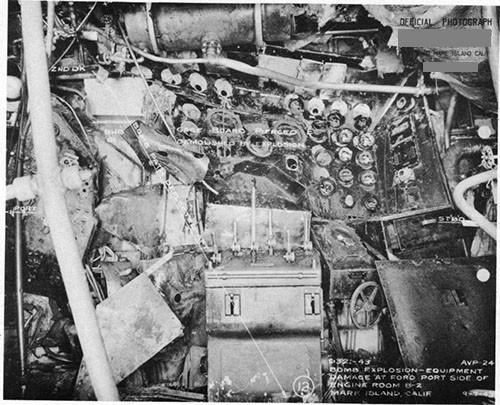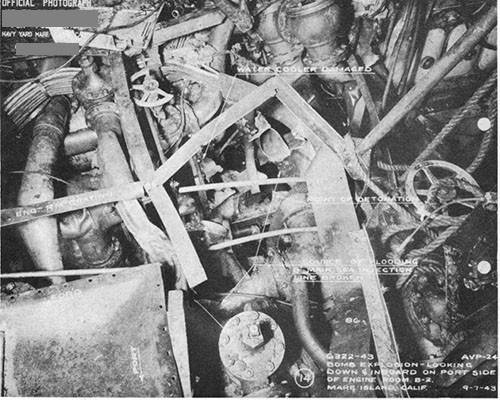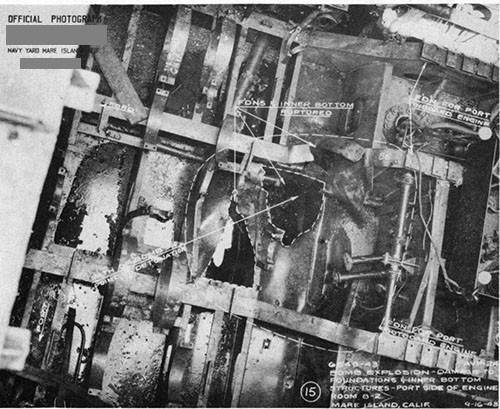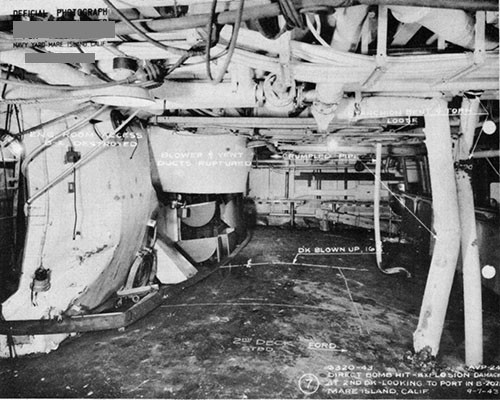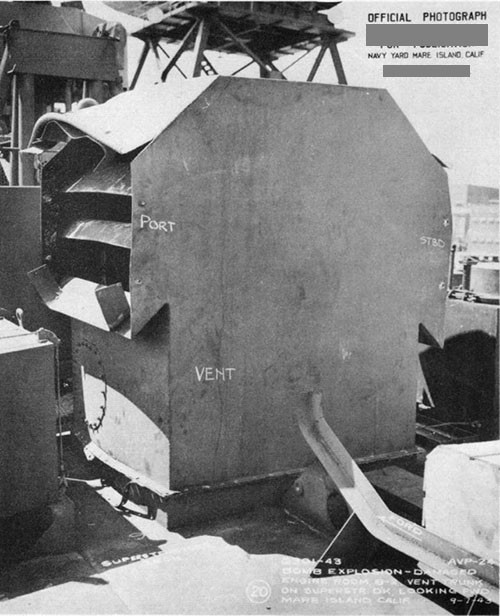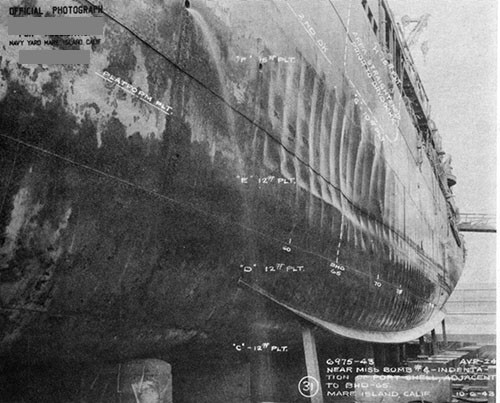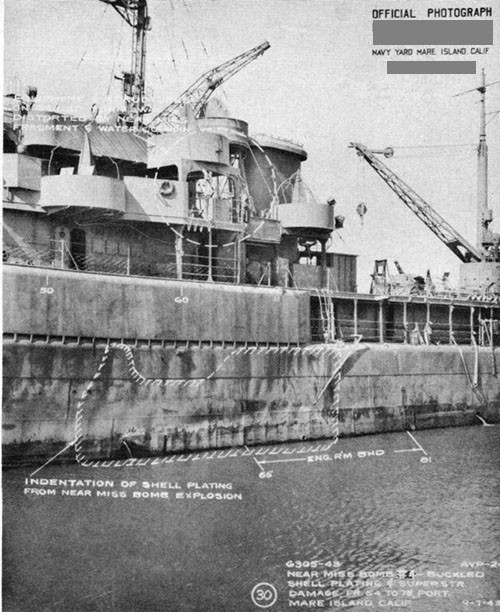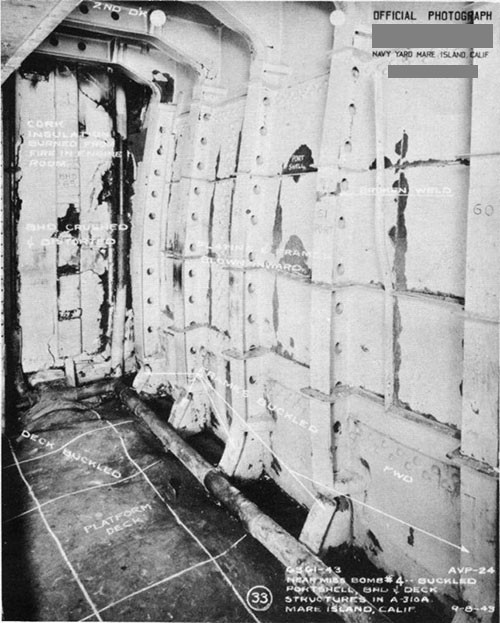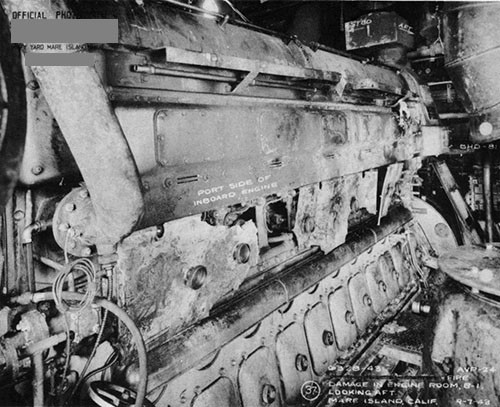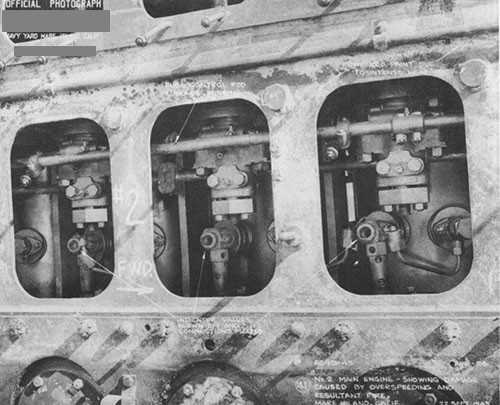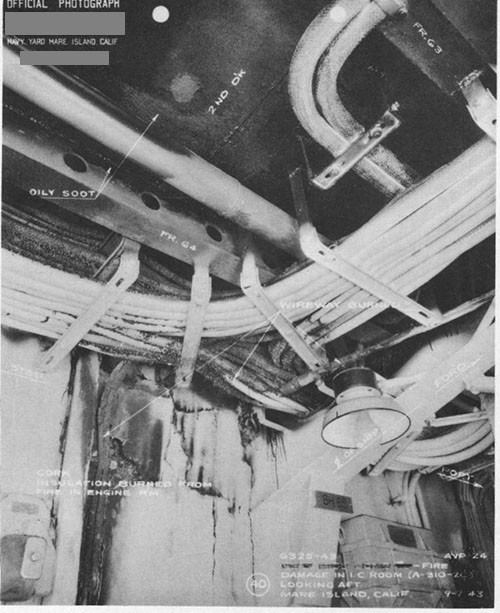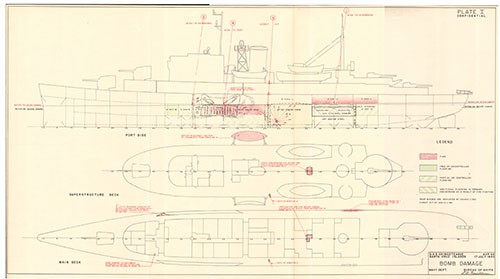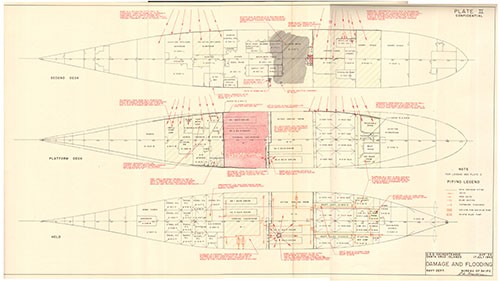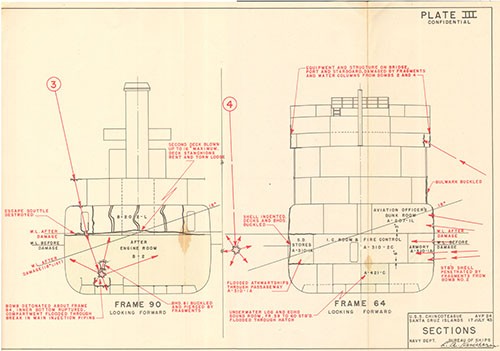
The Navy Department Library
U.S.S. Chincoteague (AVP24)
Bomb Damage
Saboe Bay, Santa Cruz Islands
17 July, 1943
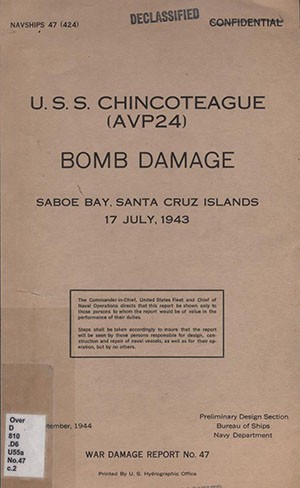
NAVSHIPS 47 (424)
CONFIDENTIAL
U.S.S. Chincoteague
(AVP24)
Bomb Damage
Saboe Bay, Santa Cruz Islands
17 July, 1943
The Commander-in-Chief, United States Fleet and Chief of Naval Operations directs that this report be shown only to those persons to whom the report would be of value in the performance of their duties
Steps shall be taken accordingly to insure that the report will be seen by those persons responsible for design, construction and repair of naval vessels, as well as for their operation, but by no others.
Preliminary Design Section
Bureau of Ships
Navy Department
20 September, 1944
WAR DAMAGE REPORT No. 47
Printed By U. S. Hydrographic Office
U.S.S. Chincoteague (AVP24)
Bomb Damage
Saboe Bay, Santa Cruz Islands
17 July, 1943
| Class | Seaplane Tender Small (AVP10) | Length (W.L.) | 300 Ft. 0 In. |
| Launched | April 15, 1942 | Beam (W.L.) | 41 Ft. 1 In. |
| Displacement | 1,695 Tons | Draft (Before Damage) | |
| Forward | 12 Ft. 0 In. | ||
| Aft | 14 Ft. 7 In. |
Reference:
(a) C.O. CHINCOTEAGUE ltr. AVP24/A9/(048) of 25 July 1943, (Action Report).
(b) C.O. CHINCOTEAGUE ltr. AVP24/A9/(054) of 28 July 1943, (War Damage Report).
(c) Comdt. NYMI ltr. AVP24/L11-1(351-621876) of 30 November 1943.
(d) C.O. CHINCOTEAGUE ltr. AVP24/A9(01) of 13 January 1944.
(e) C.O. CHINCOTEAGUE ltr. AVP24/S93 of 11 Feb. 1944.
(f) Comdt. NYMI ltr. AVP24/L11-1(351 -621904) of 20 March 1944.(War Damage Report).
(g) Comservpac ltr. Aux/S41/(70-6) (1276) of 17 Aug. 1944.
(h) C.O. CHINCOTEAGUE ltr. AVP24/S41(0111) of 18 Nov. 1944.
CONTENTS
| Section | Page |
| I - Summary | 1 |
| II - Narrative | 2 |
| III - Discussion | |
| A. Types of Bombs | 7 |
| B. Structural Damage | 8 |
| C. Machinery Damage | 9 |
| D. Fire | 11 |
| E. Stability, Flooding and Damage Control | 13 |
| F. Conclusions | 16 |
LIST OF PHOTOGRAPHS
| No. | Title |
| 1. | View of port side, showing locations of bombs. |
| 2. | Fragment holes resulting from bomb No. 1. Note torn degaussing cables and buckled beam brackets. |
| 3. | Fragment holes and water column damage resulting from bomb No. 2. |
| 4. | Location of initial impact of direct hit bomb No. 3. |
| 5. | Path of direct hit bomb No. 3 through superstructure and main decks. |
| 6. | Path of direct hit bomb No. 3 through main and second decks. Note buckled deck and bulkheads due to detonation in engine room. |
| 7. | Path of direct hit bomb No. 3 in after engine room. |
| 8. | Area in way of bomb detonation. Point of detonation probably several feet higher than shown. |
| 9. | Area in way of bomb detonation after machinery and equipment were removed. Note dishing of inner bottom panels forward of ruptures. |
| 10. | Looking to port in B-202L, showing bulging of second deck and damage to access and ventilation trunks due to blast. |
| 11. | Blast damage to ventilation cowl on superstructure deck. |
| 12. | Indentation of port shell due to detonation of bomb No. 4. |
| 13. | Damage to shell from bomb No. 4. Note damage to superstructure from water geyser. |
| 14. | Buckled structure in A-310A due to detonation of bomb No. 4. |
| 15. | View of inboard main engine in forward engine room after fire. |
| 16. | Close-up view of damage to inboard main engine. |
| 17. | Fire damage in I.C. room (A-310-2C) looking aft. |
SECTION I - SUMMARY
1. CHINCOTEAGUE underwent eleven bombing attacks on 16-17 July, 1943, while on a seaplane tending mission in the Santa Cruz Islands. The attacking groups varied from a single plane to a formation of nine bombers. Flooding which resulted from the damage was extensive. CHINCOTEAGUE's survival is attributable both to the aggressive manner in which her personnel took action to remove the damage water and to her adequate stability characteristics.
2. At 0738, on 17 July, two bombs missed the ship and landed in the water about 50 feet from the starboard side, detonating a short distance below the surface. Numerous fragments pierced the shell, some below the waterline. Several fires were ignited, including a gasoline fire, but these were effectively extinguished. Flooding through the fragment holes below the waterline reduced the GM of the vessel from about 3.2 feet to about 1.6 feet. In spite of this reduction in GM, the stability characteristics were still satisfactory for keeping the vessel upright in case of some additional damage or flooding. Efforts to plug fragment holes a short distance above the waterline were unsuccessful, and these holes caused considerable additional flooding after a later attack. Plugs inserted from the outside worked loose from some of the holes and fell out, while the ship was underway, and a mat, improvised from canvas, proved unsuitable as a watertight covering. Undoubtedly, efforts of personnel were taxed to the limit by the necessity of fueling planes, manning the anti-aircraft battery, and at the same time, endeavoring to meet all damage control requirements.
3. At 1150, some four hours later, a small general purpose bomb* with a short delay in the fuze struck and penetrated the superstructure, main and second decks and detonated in the after engine room. The hull was not ruptured, but the engine room was flooded through a broken 8-inch sea suction line supplying cooling water to the main propulsion diesel engine. As the draft increased, water entered the ship through the fragment holes above the second deck, which had not been plugged effectively. Large free surface areas were created on the second deck. CHINCOTEAGUE soon became unstable with a negative GM of about (-)0.4 feet and lolled to starboard at an angle variously reported as 12 to 18 degrees. The vessel proceeded at half speed, using the forward engines.
4. At 1420, another bomb landed in the water about 15 feet from the port side, detonating underwater. This did not rupture the hull, but the shell was indented in way of the forward engine room. The forward main engines stopped due to shock, leaving the vessel dead in the
__________
* The identification of this bomb will be discussed in paragraph 25.
--1--
water. After repairs had been made by the engine room force, the vessel got underway again at 2350.
5. At 0245, on 18 July, the inboard one of the two main propulsion diesels in the forward engine room overheated, and in an attempt to secure the engine, control was lost and the engine ran away, driving the crew from the engine room and starting a serious fire. The fire was confined to the engine room and gradually burned itself out.
6. The unusual nature of the casualty highlights the necessity for keeping heavy duty diesel prime movers under load, and thus under control when operational difficulties are encountered. This is especially true after battle damage. The racing engine forced the abandoning of the engine room. The fire which the engine caused was thus permitted to gain such headway that it was brought under control only with difficulty.
7. The condition of negative stability was the result of free surface caused by:
(a) Free water remaining from the first attack.
(b) Water on the second deck which entered after the direct hit through holes ineffectively plugged after the first attack.
(c) Flooding incident to the direct hit.
This combined flooding created a stability condition closely paralleling that of ERIE*. Jettisoning of weights from the low side was instituted in an effort to correct the list, indicating that the negative stability condition was not recognized. Fortunately, the unwatering process corrected the dangerous condition of negative stability before an upsetting moment could occur from the injudicious removal of weights. Eventually, the list was removed, and the ship was then towed to Espiritu Santo where temporary repairs were made.
8. The many and varied aspects of war damage which arose in this case, strained the damage control organization to the utmost. It is an excellent example of the contingencies for which a damage control organization must be trained.
SECTION II - NARRATIVE
(All Photos and Plates)
9. This report is based on the information contained in the references. The photographs were furnished by the Commanding Officer and
__________
* BuShips War Damage Report Number 31.
--2--
the Navy Yard, Mare Island. The plates were prepared by the Bureau of Ships from plans submitted by the Navy Yard, Mare Island.
10. On 6 July, 1943, CHINCOTEAGUE anchored in Saboe Bay, Vanikoro Island, for the purpose of carrying out seaplane tending operations. The work proceeded without incident until 14 July. On the fourteenth and fifteenth of July, several contacts were made with enemy planes. These planes, however, did not attack CHINCOTEAGUE.
11. On the morning of the sixteenth at 0717, five Japanese bombers made a bombing run, releasing at 8,000 feet, and then retired. The bombs landed in the jungle about 1500 yards away. At 1110, another formation of nine bombers was sighted. These planes made several practice runs on the vessel, during which CHINCOTEAGUE got underway by clipping the starboard anchor cable. At 1136, the planes made a bombing run which resulted in misses astern and on the port quarter. The nearest bomb, falling about 50 yards from the stern, caused minor fragment damage to the fantail, and the trainer's sight of No. 4, 5-inch/38 gun. CHINCOTEAGUE continued out to sea and after contact was lost, returned at 1300 to proceed with fueling of a patrol bomber group which was scheduled to carry out a night bombing mission.
12. There was no activity during the night. Early the next morning, the bomber group returned from its mission and landed. As the last plane was landed at 0725, CHINCOTEAGUE was bracketed by a stick of bombs from five enemy twin-engined bombers which apparently had followed the patrol bombers. The ship got underway immediately and started out of the bay. A second attack was made by the same group of bombers shortly after the ship was underway. The bombs fell about 50 yards astern. No damage was received from either of the first two attacks. At 0738, as the ship was emerging from the mouth of the bay, a third attack developed. Two bombs landed in the water about 50 feet off the starboard side, detonating a short distance below the surface opposite frames 54 and 105. Numerous fragments pierced the shell, some below the waterline.
13. Fragments from the bomb opposite frame 105 (No. 1 on Plate 1) penetrated the starboard shell strakes above and below the waterline, damaging the interior structure and starting fires in bedding in C-201L and C-202L. These fires were extinguished by means of the fixed fog sprinkler system. Hot fragments also ruptured gasoline lines at the fueling station on the main deck at frame 110 and ignited the gasoline. Damage control parties isolated the damaged portion of the gasoline system and extinguished the fire, by the use of fog nozzles. The gasoline tanks were not punctured, the 1/2-inch HTS doubler plates in way of these tanks being sufficient to prevent penetration of the shell. Minor flooding was reported in C-201L and C-202L. It is probable that this flooding was entirely due to firefighting, as the second deck at this time was about 2-1/2 feet above the existing waterline, and no appreciable list was reported. Some of the fragment holes in these compartments were plugged from the outside, and an external mat improvised from canvas was used in an attempt to cover other holes. However, while the ship was underway,
--3--
plugs worked loose and fell out, while air gaps along the edges of the mat nullified its value. It will be brought out later how this failure to make the hull watertight above the second deck permitted the formation of large areas of free surface which would have been avoided had the holes been plugged effectively at this time.
14. Cofferdam C-6V flooded to the waterline through fragment holes. All compartments in the refrigerator space on the platform deck between bulkheads 113 and 121, except the meat room, flooded to a depth of 4 feet through fragment holes in the shell below the second deck. This flooding was eliminated by opening manholes in the platform deck and allowing the water to enter stuffing box compartments C-414E and C-413E from which it was pumped overboard by the ship's drainage system. Aviation lubricating oil pump room C-415E flooded to the overhead through open watertight access hatch 3-117-1 on the platform deck. Fragment holes below the second deck were plugged.
15. As a result of the bomb (No. 2 on Plate I) detonating opposite frame 54 starboard, numerous fragments dented and pierced the shell of the vessel. Little interior damage was noted. The column of water caused by the bomb detonation deluged the topsides and buckled the 1/4-inch STS splinter protection bulwark on the main deck in way of the torpedo stowage. Hot fragments ignited the starboard motor whaleboat. The fire was extinguished quickly. Water entered all starboard compartments between bulkheads 44 and 65 on the platform deck through fragment holes in the shell. The armory (A-310-1A) flooded to a depth of 2 feet 6 inches. Water traveled athwartships through non-watertight doors, flooding the passageway and S.D. stores A-310-1A on the port side to about the same depth. Torpedo workshop A-310-1AE flooded to a depth of one foot. The water in these compartments was eventually cleared by plugging the fragment holes and using submersible pumps and bucket brigades. In S.D. stores A-310-1A, many loose papers hampered the unwatering process by intermittently clogging the strainers of the submersible pumps. 20mm clipping room A-308M and 20mm magazine A-309M also flooded to a depth of one foot. Fragment holes in these compartments were plugged and the water removed by a bucket brigade. As reported in reference (f), small arms magazine A-307M flooded to the waterline through fragment holes. Underwater sound room A-421C flooded completely through watertight hatch 3-59-1 in passageway A-310-1A, which was not properly secured. These two compartments were not unwatered until drydocking. The fragment holes in aviation bunk room A-207-1L on the second deck above the waterline, were not plugged properly and resulted in some flooding during later attacks when a list developed.
16. After reaching the open sea, CHINCOTEAGUE was attacked by four planes at 0805. All bombs fell clear and no damage resulted. The enemy planes withdrew and the vessel returned to the bay to fuel planes. At 1020, the ship weighed anchor and left the bay. At 1120,
--4--
enemy planes were again contacted and at 1145, the first bombing run took place. All bombs fell clear.
17. Five minutes later, a second attack developed. In this attack, the vessel was struck by a small general purpose bomb with a short delay in the fuze. The bomb pierced the superstructure deck between frames 81 and 82 about 18 inches inboard of the port deck edge, and continued through the main and second decks, traveling almost vertically downward and slightly inboard. After piercing the second deck, the bomb was deflected aft by bulkhead 81 and detonated in the after engine room at about frame 84, just forward of and between the two diesel main engines. The inner bottom was ruptured, but the shell of the vessel was not pierced. Foundations and piping in the vicinity of the detonation were demolished. An 8-inch suction line, supplying cooling water to the main propulsion diesel engines was ruptured. The engine room flooded to the overhead. The port side of bulkhead 81 was badly buckled and ruptured and bulkhead 80 was distorted and punctured. The second deck above the engine room was bulged up a maximum of 16 inches over the detonation. Other effects of the blast were noted in damaged access and ventilation trunks. The rapid flooding of the after engine room and other material damage resulted in loss of power to the port shaft and rendered useless other important auxiliaries. CHINCOTEAGUE remained at sea following this attack, maintaining a speed of 10 knots by the forward engines. The flooding resulting from No. 3 bomb caused the vessel to settle and trim by the stern, placing the second deck aft of amidships below the waterline. Compartments C-201L and C-202L began to flood slowly through the ineffectively plugged fragment holes. This flooding reduced the stability of CHINCOTEAGUE to a negative value and a list to starboard developed. This resulted in increased flooding in C-201L and C-202L and caused water to enter aviation bunk room A-207-1L.
18. At 1420, of the same afternoon, three bombers dropped numerous bombs which bracketed the ship. One bomb detonated about 15 feet from the port side at frame 65. The detonation dented a large area of shell plating between frames 54 and 74. The plating was neither ruptured nor pierced by fragments. The main area of indentation extended from about 2 feet above the waterline to about 5 feet below with less indentation extending up to the main deck. The column of water also deluged the topside, doing damage to equipment. Shock broke electrical equipment and gages in the forward engine room. At this point, the forward main engines stopped, leaving CHINCOTEAGUE dead in the water.
19. At 1450, with CHINCOTEAGUE dead in the water, a single plane made another attack. No damage resulted, as the bombs fell about 200 yards abeam. At about 1800, the eleventh and final attack was made, but the enemy planes were driven off by air cover which had been provided in the meantime. CHINCOTEAGUE at this point
--5--
had lost all power, was flooding slowly in many compartments, and was listing to starboard.
20. All available men were pressed into service to control the flooding. With no power available, only the gasoline handy billy pumps could be used. These were augmented by extensive bucket brigades. These were not enough, and despite all efforts, the water continued to gain. Later that night, it was discovered that the flooding in the forward engine room could be held below the level of the floor plates and an attempt was made to regain power. The generators were successfully started, and the main engines were put into commission. At 2350, the vessel got underway.
21. About one hour later, THORNTON (AVD11) arrived and transferred additional handy billy pumps to CHINCOTEAGUE. These pumps, along with the electric submersible pumps now in operation, were of considerable help in keeping even with the flooding. During the night, two electrical fires started in the forward engine room and were extinguished with CO2.
22. At 0230, on 18 July, the inboard (No. 2) main engines began to overheat and black smoke was emitted from the stack. At 0245, it was decided to investigate the engine. It was not desirable to stop both main engines simultaneously since all starting air had been exhausted and it would have been impossible to restart them. The procedure followed in picking up the THORNTON small boat two hours previously, had been to place the engines in idling position and then dump the oil from the hydraulic clutch, thus taking power off the propeller shaft. The same procedure was followed in investigating the overheating of No. 2 engine. When the load was removed, however, the engine began to speed up. The throttle was closed with no apparent effect. No. 2 engine picked up speed rapidly and within 30 seconds, had reached a dangerously high speed. No. 1 engine was secured, and the engine room abandoned with No. 2 engine racing out of control. The runaway engine started a fire. An effort was made to smother the fire by closing all access openings and at the same time foam generators were set up. THORNTON came alongside, hoses were connected to her fire mains and foam poured into the compartment. The fire was fought until 0545, when the last of the foam was expended. The compartment was then battened down and all intakes plugged. The fire at this time appeared to be localized, but still smoldering. The after bulkhead of I.C. Room A-310-2C was kept cool by spray from a gasoline handy billy pump.
23. At 0740, the tow line was broken because of a submarine contact. THORNTON resumed the tow at 0939 and continued until 1217, at which time the list had increased to a point where the tow had to be dropped. Flooding contained to gain despite the efforts of the crew. The stern had settled and the list was variously reported as 12 to 18 degrees starboard. Orders were given to lighten ship. Torpedoes, heavy machinery,
--6--
winches and other gear on the starboard side were jettisoned. Apparently, as the result of a radio request to Espiritu Santo, additional pumps were flown in by a patrol plane. These eventually removed much of the free surface. THORNTON again came alongside at 1304 to furnish power for submersible pumps and remained until the following morning. During the night of the eighteenth, CHINCOTEAGUE remained dead in the water with THORNTON alongside. JENKINS (DD447) and TREVER (DMS16) acted as anti-submarine screen. Pumping and bucket brigades continued without stop.
24. Heavy seas forced THORNTON to cast off on the morning of 19 July. The tug SONOMA (AT12) came alongside at 1113 with additional pumping equipment and took CHINCOTEAGUE in tow, arriving at Espiritu Santo at 0825 on 21 July. After temporary repairs to make the hull watertight were accomplished, CHINCOTEAGUE was towed to Navy Yard, Mare Island, arriving 4 September, 1943. All battle damage was repaired and many authorized alterations completed. The vessel is now back in service.
SECTION III - DISCUSSION
A. Types of Bombs
25. From fragments recovered, the bomb which struck CHINCOTEAGUE has been identified by the U.S. Navy Bomb Disposal School, Washington, D.C., as a Japanese Type 99, No. 6. This has a total weight of 63 Kg. (136.4 pounds) and contains an explosive charge of 32 Kg. (70.4 pounds) of picric acid. It has a machined case which has caused some authorities to classify it as a semi-armor-piercing bomb. However, the percentage of explosive weight is 50.8, which places it in the U.S. general purpose category. The bomb passed through three decks totaling 13/16 inches in thickness, pierced a door frame and detonated some 25 to 30 feet from the point of initial impact - indicative of a short delay, of the order of .025 - .030 seconds, in the fuze. The fragment damage from the two bombs which landed a short distance from the starboard side, was consistent with that which would be caused by bombs of the same size as that which hit the ship. Their fuzing was such as to cause detonation a short distance below the surface of the water.
26. Bomb No. 4 is reported to have detonated below the surface of the water about 30 feet from the port shell of the vessel. The references estimate this to have been a 500-pound bomb. The damage to the side of the vessel indicates that the bomb was probably smaller and closer to the shell. There is no evidence of fragment attack, an indication that the fuze was set with a short delay which caused detonation below the surface. The indentation of the shell consisted of two portions. The deeper of these extended from frames 60 to 70 and from the waterline to about 7 feet below the waterline. The maximum
--7--
indentation seems to have occurred at about bulkhead 65. Above this area, a region of shallower indentation extended to the main deck. This is clearly shown in photo 12. The position of the deeper indentation indicates that the bomb detonated about 3 or 4 feet below the surface. The area of indentation was quite small, thus placing the detonation fairly close to the vessel. The damage was of the order of that caused by small charges fairly close to the hull. The area of shallower indentation above the waterline and the reported damage to bridge equipment is clearly a result of the accompanying water geyser. This is still another sign that the detonation occurred quite close to the hull. The evidence thus indicates that this bomb was one of the 63Kg. type and that it detonated a short distance below the surface, not far from the hull.
27. When bombs Nos. 1 and 2 detonated close to the surface about 50 feet from the ship, some fragments with a trajectory over the surface of the water pierced shell plating below the waterline. Apparently, that portion of the hull was exposed above the surface of the water while the ship was rolling or heeled in a turn. The plating penetrated was light, 3/10 to 1/4-inch medium steel. Although bomb No. 4 landed closer to the ship, its detonation was sufficiently deep beneath the surface and still far enough away to prevent fragment penetration. The behavior of the fragments from these bombs was consistent with the damage caused by a bomb of a similar size and type which detonated upon impact with the main deck of CHESTER (CA27)*. In that case, several fragments traveled a horizontal distance of over 100 feet: through the 1/4 and 3/16-inch medium steel bulkheads of the wardroom pantry to dent the 1/4-inch forward bulkhead of the wardroom.
28. On vessels of the same class as CHINCOTEAGUE, the shell plating in way of the gasoline tanks is somewhat heavier than the shell in other locations in order to provide a margin for corrosion. A 1/2-inch doubler (some of the ships have STS), was installed over the shell in way of these tanks for fragment protection. It is notable in the case of CHINCOTEAGUE that although the bomb fragments made many indentations in the HTS doubler, the shell itself was not penetrated.
B. Structural Damage
29. Reference (f) states that the bomb which struck the ship detonated "just above the inner bottom" between frames 85 and 86. Careful study of the references and photographs indicates that the point of detonation probably was somewhat higher, possibly just above the engine room floor plates. This estimate is based on the facts that the damage to the inner bottom and foundations was sharply localized (Photos 7 and 8) and has the appearance of having been caused by large fragments rather than blast. The effects of blast are evidenced by the bulging of the second deck (Photo 10), the distortion of bulkhead 81 and the indentation of the panels of the inner bottom forward of the disrupted area
___________
* Buships War Damage Report No. 10.
--8--
(Photo 8). Bulkheads 81 and 80 were also punctured by fragments. These facts tend to place the center of detonation somewhat higher than reported. Possibly the bomb tumbled after penetrating the second deck and was nose-up when detonation occurred. In any event, the structural damage was somewhat less than would be expected normally from a bomb of this size.
C. Machinery Damage
30. Machinery and electrical damage from bombs Nos. 1 and 2 was caused entirely by flooding with the exception of degaussing cables which were cut by fragments in several places. Damage to the machinery in the after engine room, caused by the bomb which hit the ship, was not extensive, considering the location of the detonation.
31. The engineering casualty in the forward engine room occurred at a critical time. It resulted in a serious fire and the loss of all power when power was urgently required to provide pumping capacity. The cause of the casualty is not clear. The rapidity of events and the subsequent fire make an analysis of the evidence difficult. A study of the case, however, reveals the following facts and probabilities.
32. The flooding of the after engine room left the mobility of the vessel dependent upon the two 1600 h.p. Fairbanks-Morse diesel engines geared to the starboard shaft. The operation of these engines was further complicated by the fact that all starting air had been expended. Although not specifically reported, presumably some casualty to the air system prevented the replenishment of the air supply. This made it imperative that the engines not be stopped simultaneously for any reason, since they could not be started again. After operating satisfactorily for about three hours, the port (inboard) engine began to overheat and it was noticed that an abnormal amount of lubricating oil was being used. The temperature of the exhaust, normally about 600°F, was found to be 800°. About 150 gallons of lubricating oil disappeared in approximately 15 minutes, indicating a probable failure in some portion of the lubricating oil system as a result of bomb No. 4. Smoke from the stack appeared to be thick and black. The exact condition of the engine could not be observed since all gages had been damaged. After twenty minutes it was decided that it was dangerous to operate the engine further. Both engines were brought to slow speed and the hydraulic clutch on the port engine dumped, releasing the load. The engine began to pick up speed immediately. The throttle was closed with no apparent result. The governor and overspeed trip did not operate. The engine reached a dangerously high speed in 30 seconds. Cylinder relief valves blew open, the indicator card cocks blew off and black smoke poured into the engine room. The engine room was abandoned and all hatches secured with the engine racing at high speed. The fuel oil shut-off valve was not closed
--9--
due to the speed of events and because it was believed that the engine was running away on lubricating oil rather than diesel oil. Reference (h) states that the hydraulic clutch was not reconnected because "it was felt that the engine would be damaged by a sudden increase of load upon it". The engine finally stopped when the pistons seized. According to reference (f), the cylinder liners were so badly warped that a 90-ton jack was necessary for the removal of the pistons at Mare Island.
33. After the fire caused by the runaway engine was extinguished, an inspection of the engine revealed that the blower which supplies the engine with scavenge air had two inches of oil in the bottom of the casing. A more complete inspection upon arrival at Mare Island disclosed two important points. First, an examination showed that the fuel control rods which operate the fuel injection pump control racks had elongated, due to heat, and as a result, ten of the fuel injection pump control racks were open from one-third to full when the throttle was closed. The fuel injection pumps near the throttle end were closed, while those farther away were open by amounts which increased as the distance from the throttle increased. Second, it was discovered that the air intake filter to the blower, which is horizontal, was severely clogged with foreign matter. The filter, upon inspection, was so heavily clogged that water would not "pour" through it. Furthermore, it had been belled down into the intake pipe by the excessive vacuum created between the screen and the blower.
34. It is evident that the detonation of bomb No. 4 shook down foreign matter onto the filter. It is not probable that the air filter was as completely clogged at the time of the casualty as was reported, since a considerable amount of air would have to be available for the engine to overspeed. It is more probable that the air filter was sufficiently clogged so as to seriously reduce the supply of air to the engine. The first result of this constriction would be incomplete scavenging of the cylinders and some incomplete combustion of the fuel charge. This incomplete scavenging was undoubtedly the cause of the initial overheating of the engine.
35. Subsequent events make it seem quite probable that the scavenging air being supplied to the cylinders was laden with more or less atomized lubricating oil from a source in the blower. It is unusual for partially atomized lubricating oil entering through the scavenge ports to operate a diesel engine. If, however, a small amount of diesel oil, with properly timed injection, is injected into the cylinder, the lubricating oil will burn with the diesel oil, providing additional power. It is believed that such was the case in the subject casualty. The condition of the fuel control rods described in paragraph 32 has been advanced to explain the existence of diesel injection with the throttle closed. It cannot be stated positively that the expansion of the fuel control rods occurred during the overheating of the engine and before the load was removed, since this condition might have been a result of the severe fire which followed.
--10--
Indeed, the position of the fuel control rods in the engine militates against this assumption, since they are not located adjacent to any hot surface. The heat required to expand the fuel control rods the necessary amount approaches that of an oil fire. No fire was reported in the engine before the casualty. It is more reasonable to believe that the shock produced by bomb No. 4 caused the sticking or jamming of a number of fuel control racks. These racks are actuated positively by the control rods in opening, but work against a spring when the throttle is closed. Those racks which were jammed or stuck would merely compress the springs, rather than close. The expansion of the control rods during the ensuing fire would effectively mask the original condition of the racks.
36. The rapidity with which the engine reached a dangerous speed, and the clouds of black smoke emitted, prevented an appraisal of the cause of the casualty by the operating personnel. As a result, the engine room was evacuated immediately to prevent loss of life. Upon studying the facts, many of which were not available to the operating personnel at the time, it is evident that the engine probably would have stopped if the fuel oil shut-off valve had been closed. This would have removed the timing influence of the diesel injection, as well as the diesel oil supply itself. There is no service experience which indicates that a diesel can reach dangerous speeds burning lubricating oil alone.
37. In addition, the surest way to halt a runaway engine is to put it under load. Probably no vital damage to the machinery would have been caused by the refilling of the hydraulic clutch as was feared by the operating personnel. In any event, the damage incurred could hardly have been greater than that which resulted from allowing the engine to run away.
38. The governor and overspeed trip, which are designed to prevent overspeeding of the engine, operate to close the throttle. The devices were powerless to prevent the engine from running away in this instance, since the throttle had already been closed by hand and it was obvious that the source of fuel was not controlled by the throttle. In reference (g) it was recommended that an air shut-off device be provided to prevent overspeeding when fuel is being supplied, independent of the throttle. Past experience with diesels indicates that such a device is not particularly effective on large engines. Inasmuch as this type of casualty is rare and the closing of the fuel oil shut-off valve or the re-engaging of the load will prevent its occurrence, such a device appears to be unnecessary.
D. Fire
39. Fires occurred at the starboard gasoline fueling station on the main deck, in bedding in compartments C-201L and C-202L, and in No. 1 motor whaleboat as a result of fragments from bombs Nos. 1 and 2. These fires were isolated, confined and extinguished in
--11--
twenty minutes. The gasoline fire was extinguished by the use of hose lines equipped with three-position, all purpose nozzles. Non-automatic fixed fog nozzles, installed in B-202L, C-201L, and C-202L to protect the gasoline pump rooms and the gasoline tanks below, were used in extinguishing the bedding fires.
40. Non-automatic fixed fog sprinkler systems such as those which were used to extinguish the bedding fires in C-201L and C-202L are not installed for the purpose of actually extinguishing a fire. The intended purpose is to permit sprinkling to be carried out progressively from one compartment to another, in the event of a major conflagration, starting with a tenable compartment and working toward the origin of the fire. Sprinkling in each compartment should be continued only long enough to insure that it is tenable when entered. Fixed fog sprinkler systems have certain limitations which should be recognized:
(a) The system will control the surface flame in ordinary combustibles such as dry stores, bedding, and clothing, but will not of itself completely extinguish a deep-seated fire in these materials until the compartment is more or less completely flooded - not only a lengthy process, but also one which introduces an unnecessary amount of water inside the ship.
(b) There is a possibility that the extent of such a system may defeat its intended purpose. There may be some segregated sections of the fire main in which the pumping capacity is not sufficient to supply an adequate amount of water to parts of the fixed fog sprinkler system, as well as to vital hose lines which may be in use at the same time.
(c) The possibility of rapidly creating large, wide areas of free water. In cases of reduced stability, the resultant free surface effect may further jeopardize the safety of the ship.
(d) The possibility of impairment of watertight integrity due to inadvertently leaving off caps of hose connections of the fixed fog installations, subsequent to periodic cleaning of these systems with compressed air.
41. No fire resulted from the direct hit. The fire in the forward engine room which followed the overspeeding of No. 2 main engine was brought under control with difficulty and apparently burned itself out. The source of the fuel which fed the fire was not reported, but presumably was diesel oil. The engine room was abandoned when the inboard main engine raced out of control. As a consequence, the fire, which probably could have been extinguished by CO2 at the outset if personnel had been in the engine room, presumably gained fifteen or twenty
--12--
minutes headway before active measures were taken to combat it. This would be sufficient time for a fire to heat the exposed structure to the point where the fuel would be re-ignited after the actual flames had been snuffed out. In addition, the fire parties were at a disadvantage in fighting the fire from outside the compartment, as there are few convenient openings into an engine room. The fire was fought by introducing foam through second deck openings of the engine room. This was not particularly effective, as much of the oil on the surface could not be reached and continued to burn. The difficulties experienced in extinguishing this fire are typical of those which will be experienced with oil fires in engineering spaces which are not immediately taken in hand.
E. Stability, Flooding and Damage Control (All Plates)
42. The flooding suffered by CHINCOTEAGUE resulted in a stability condition which threatened the survival of the vessel. Although the sequence of flooding of the various compartments is established by the time of the respective bomb hits, the length of time each compartment remained flooded and the total flooding existing when the ship reached its maximum list, are not precisely known because of the overlapping of measures taken to control the situation. The reported behavior of the vessel, however, provides strong clues to the determination of the unreported elements.
43. The drainage facilities were adequate to handle a moderate amount of flooding. The main drain was served by two electric-driven fire and bilge pumps, with a capacity of 375 g.p.m each, one located in each engine room (see Plate II). At the time of the damage, there were on board five portable electric submersible pumps at 200 g.p.m. each and two gasoline handy billy pumps at 60 g.p.m. each. It is assumed that these were all available for use. Exclusive of the gasoline handy billy pumps, a total pumping capacity of about 263 tons per hour was provided.
44. The condition of the vessel before damage has been reported completely. The drafts before damage were 12 feet 0 inches forward and 14 feet 7 inches aft. This corresponds to a displacement of about 2,890 tons, which is 155 tons over the full load displacement as given in the Inclining Experiment Data. The metacentric height (GM) in this condition is 3.2 feet (neglecting free surface in intact ship's tanks).
45. Flooding first occurred at 0738 on 17 July, due to fragment damage from bombs Nos. 1 and 2. As shown in Plate II, two hold compartments, A-421C and C-415E, were flooded completely through access hatches on the platform deck which were not securely dogged. Seven compartments on the platform deck were partially flooded (A-307M, A-308M, A-309M, A-310-1A, A-310-2C, C-6V and C-307-1E). About 168 tons of water were taken aboard in these spaces, the new drafts
--13--
after damage being about 13 feet 0 inches forward and 15 feet 2 inches aft, corresponding to a displacement of 3,058 tons. Freeboard at the lowest point (frame 125) was reduced from about 8 feet 4 inches to 7 feet 7 inches. As a result of the free surface due to partial flooding, the GM was reduced to about 1.6 feet. It appears, then, that directly after the first attack stability characteristics were such that a moderate amount of additional flooding could be absorbed without placing the vessel in in jeopardy.
46. A little over 4 hours elapsed between the first attack and that in which a direct hit was received. During this interval, measures were taken to stop the flooding and remove the damage water.
47. At least four compartments were not emptied and remained flooded until the vessel was drydocked. These were A-307M (on the first platform), A-421C, C-6V and C-415E (in the hold). Although the amount of water in three of these spaces was small, the free surface in A-307M was sufficient to reduce GM by about 0.4 feet. Water in the refrigerator space on the platform deck between bulkheads 113 and 121 was drained into stuffing box compartments C-413E and C-414E from which it was pumped overboard using the main drain. On the other hand, water on the platform deck in the spaces between frames 54 and 65 was removed eventually by bucket brigades, and submersible and handy billy pumps. Possible, unwatering here could have been accomplished by opening the hatch at frame 60 port which leads down to compartment A-420A (see Plate II). This latter space likewise has an outlet to the main drain.
48. As a result of the direct hit at 1150, the after engine room flooded to the overhead through the 8-inch cooling water suction line. The shaft alleys flooded, due to water from the after engine room leaking through the shaft glands in bulkhead 97. The forward engine room was flooded to the level of the floor plates by water coming through cable stuffing tubes, a hole where a 1-1/2-inch line was knocked loose and three small splinter holes on the port side of bulkhead 80. Tank B-4W flooded to the level of the after engine room through a rupture in bulkhead 81 port. As the ship sank deeper in the water, compartments A-207L, B-202L, C-201L and C-202L on the second deck flooded to the waterline.
49. About 663 tons of water were taken aboard as a result of the direct hit. The corresponding displacement was about 3,721 tons. The estimated drafts after this attack were 15 feet 2 inches forward and 18 feet 3 inches aft, the freeboard at frame 125 being reduced to about 4 feet 10 inches in the upright condition. The drafts of 11 feet forward and 16 feet aft, reported in reference (f), are obviously in error, since these drafts correspond to a displacement only 50 tons greater than the intact displacement.
--14--
50. Shortly after the direct hit, the vessel assumed a heavy starboard list, variously reported as 12 to 18 degrees, putting the main deck edge a few inches above the water. A study of the flooding (see Plate II) indicates that it was largely symmetrical. A small amount of off-center flooding, however, did exist (chiefly in A-207-1L), the resultant moment being about 50 tons-feet to starboard. This small moment alone does not account for the large list. No displacement of large machinery weights occurred. Free surface was present in four large, wide compartments on the second deck, as well as in several smaller spaces. Consequently, the situation following the direct hit can be identified definitely as one of negative GM with a small amount of unsymmetrical flooding. Paragraph 4-17 of FTP170-B states that this condition of negative stability should be suspected whenever heavy list is accompanied by small off-center flooding and extensive free surface. Such was the case with CHINCOTEAGUE. The ship was in a dangerous state, and her ability to remain upright and survive was dependent upon the rapid application of proper corrective measures.
51. Had unwatering been completed and fragment holes above the second deck been adequately plugged prior to the direct hit, calculations indicate that GM after the hit would have had a positive value of about 2.1 feet. This includes the correction for free surface in B-1 and B-202L. List probably would have been negligible. However, free surface still present in A-307M reduced GM to about 1.7 feet. In addition, free surface occurring in ineffectively plugged compartments C-201L and C-202L further reduced GM to the extent that shortly after the direct hit, GM had a negative value of about (-)0.4 feet. The ship heeled over to that angle of list where the shape of the hull was such as to restore positive stability characteristics.
52. Although the fragment holes remaining after the first attack in way of certain of the second deck compartments presented a definite hazard in case of list or further sinkage, efforts to plug or cover them over with a mat during the period between the first two misses and the direct hit, were unsuccessful. The first attempt to plug these holes was made from the outside. The Commanding Officer reported that when the vessel was underway, the plugs worked loose and fell out because of the action of the sea. In those holes (below the second deck) which were plugged from the inside, the plugs remained effective. The Commanding Officer considered that the attempts to plug holes from the outside were ill-advised.
53. CHINCOTEAGUE, after the second attack, was unstable at angle of heel less than about 12 to 18 degrees. Initial efforts to right the ship were based on removing the water by means of gasoline handy billy pumps and bucket brigades. However, progress was slow, and on the morning after the direct hit, the list still was varying between 12 and 18 degrees. The order was given to lighten ship. Torpedoes, heavy machinery, winches and other heavy gear were jettisoned from the starboard, or low side. About 12.75 tons were jettisoned, producing 150 tons-feet of moment. While this weight removal was in process, the pumps supplied by plane were rigged and proved capable of supplying the additional capacity necessary to remove a great deal of the free surface.
--15--
54. The attempts to unwater the ship were undertaken under great difficulties, among which were intermittent loss of power, a large angle of list, firefighting and the necessity of maintaining battle stations under enemy air attack. It is not surprising, then, that these efforts were prolonged. A compartment must be almost "dried out" if it is to have a markedly beneficial effect on stability. With stability difficulties, it is well to remember that half-way measures are of little avail. In all cases, every effort should be made to unwater completely all partially flooded compartments. With limited manpower and facilities available to cope with flooding in many compartments, the priority of which to unwater first must be considered. Wide or off-center spaces should be attended to first, as was done in this case, after the first attack with the compartments on the platform deck between frames 54 and 65.
55. The resultant moment produced by the unsymmetrical flooding was small, only about 50 tons-feet. When applying corrective measures, it is safer to treat a borderline case like this is, as one of negative GM with symmetrical flooding, concentrating first solely on improving the stability characteristics. Quoting paragraph 4-16 of FTP170-B, "...this situation causes a list which cannot be corrected except by improving stability. Efforts to remove such a list by pumping liquids overboard or from one tank to the other will result in an approach toward the upright in a normal fashion, until at some angle short of the upright position, the ship will suddenly lurch to a larger angle on the opposite side ... Any attempt to correct the list under these conditions, except by improving GM, is dangerous and will lead to a heavy lurch and possible capsizing, to the other side." ERIE* capsized after injudicious transfer of weights and liquids while the vessel was unstable. It was fortunate that the total of weights jettisoned from CHINCOTEAGUE was small and that pumping efforts were effective in restoring the stability of the vessel before jettisoning could cause further trouble. The jettisoning of weights to improve stability is often a slow and tedious process, compared to the elimination of free surface from partially flooded compartments. When it is resorted to, it should be carefully supervised. Chapter 4 of FTP170-B contains a very complete discussion of these points.
F. Conclusion
56. In spite of extensive damage and flooding, CHINCOTEAGUE's personnel succeeded in saving their ship. This achievement is all the more remarkable in view of the comparative inexperience of the crew. Only about a month had elapsed from the time the ship left San Diego upon completion of post shakedown repairs, until this action occurred.
__________
* Buships War Damage Report No. 31.
--16--
57. This case is an apt illustration of the varied types of casualties that may confront a ship as the result of war damage. It also serves to emphasize that the cumulative effect of several incidents, each of which in itself may be comparatively insignificant, can definitely jeopardize a ship.
--17--
